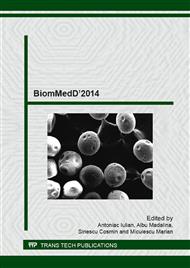[1]
J.M. ten Cate, Contemporary perspective on the use of fluoride products in caries prevention, Br. Dent. J. 214 (2013) 161-167.
DOI: 10.1038/sj.bdj.2013.162
Google Scholar
[2]
N. Pitts, R.M. Duckworth, P. Marsh, B. Mutti, C. Parnell and D. Zero, Post-brushing rinsing for the control of dental caries: exploration of the available evidence to establish what advice we should give our patients, Br. Dent. J. 212 (2012).
DOI: 10.1038/sj.bdj.2012.260
Google Scholar
[3]
C. Vitelaru, A.C. Parau, M. Balaceanu, F. Miculescu and A. Vladescu, Corrosion behaviour of Ti6Al4V alloy in artificial saliva solution with fluoride content and low pH value, Mat. -wiss. u. Werkstofftech. 45 (2014) 91–98.
DOI: 10.1002/mawe.201400191
Google Scholar
[4]
M. Karthega, S. Tamilselvi and N. Rajendran, Effect of pH on the corrosion behaviour of Ti-6Al-4V alloy for dental implant application in fluoride media, Trends Biomater. Artif. Organs 20 (2006) 31-34.
Google Scholar
[5]
T.P. Chaturvedi, Allergy related to dental implant and its clinical significance, Clin. Cosmet. Investig. Dent. 5 (2013) 57–61.
Google Scholar
[6]
M.H. Fathi , M. Salehi, A. Saatchi, V. Mortazavi and S.B. Moosavi, In vitro corrosion behavior of bioceramic, metallic, and bioceramic–metallic coated stainless steel dental implants, Dent. Mater. 19 (2003) 188–198.
DOI: 10.1016/s0109-5641(02)00029-5
Google Scholar
[7]
G.T. Liu, J.G. Duh, K.H. Chung and J.H. Wang, Mechanical characteristics and corrosion behavior of (Ti, Al)N coatings on dental alloys, Surf. Coat. Tech. 200 (2005) 2100–2105.
DOI: 10.1016/j.surfcoat.2004.07.124
Google Scholar
[8]
C.M. Cotrut, C. Vitelaru, M. Dinu, T. Petreus and A. Vladescu, Synthesis and Characterization of TiSiON biocompatible thin films used in biomedical applications, Sci. Adv. Mater. 6 (2014) 1–10.
DOI: 10.1166/sam.2015.2051
Google Scholar
[9]
J.R. Scully, Polarization resistance method for determination of instantaneous corrosion rates, Corrosion 56 (2000) 199-218.
DOI: 10.5006/1.3280536
Google Scholar
[10]
D.C. Silverman, Practical corrosion prediction using electrochemical techniques, in: R.W. Revie (Ed. ), Uhlig's Corrosion Handbook, 2nd edition, The Electrochemical Society, (2000).
DOI: 10.1002/9780470872864.ch85
Google Scholar
[11]
L. Reclaru and J.M. Meyer, Effects of fluorides on titanium and other dental alloys in dentistry, Biomaterials 19 (1998) 85-92.
DOI: 10.1016/s0142-9612(97)00179-8
Google Scholar
[12]
G. Mabilleau, S. Bourdon, M.L. Joly-Guillou, R. Filmon, M.F. Baslé and D. Chappard, Influence of fluoride, hydrogen peroxide and lactic acid on the corrosion resistance of commercially pure titanium, Acta Biomter 2 (2006) 121–129.
DOI: 10.1016/j.actbio.2005.09.004
Google Scholar
[13]
N. Schiff, B. Grosgogeat, M. Lissac and F. Dalard, Influence of fluoridated mouthwashes on corrosion resistance of orthodontics wires, Biomaterials 25 (2004) 4535–4542.
DOI: 10.1016/j.biomaterials.2003.11.042
Google Scholar
[14]
P.N. Mane, R. Pawar, C. Ganiger and S. Phaphe, Effect of fluoride prophylactic agents on the surface topography of NiTi and CuNiTi wires, J. Contemp. Dent. Pract. 13 (2012) 285-288.
DOI: 10.5005/jp-journals-10024-1138
Google Scholar
[15]
A.M. Barcelos, A. Severino Luna, N. de Assis Ferreira, A.V. Castro Braga, D.C. Baptista do Lago and L. Ferreira de Senna, Corrosion evaluation of orthodontic wires in artificial saliva solutions by using response surface methodology, Mater. Res. 16 (2013).
DOI: 10.1590/s1516-14392012005000172
Google Scholar
[16]
M.P. Walker, R.J. White and K.S. Kula, Effect of fluoride prophylactic agents on the mechanical properties of nickel-titanium-based orthodontic wires, Am. J. Orthod. Dentofacial Orthop. 127 (2005) 662–669.
DOI: 10.1016/j.ajodo.2005.01.015
Google Scholar
[17]
I. Watanabe and E. Watanabe, Surface changes induced by fluoride prophylactic agents on titanium-based orthodontic wires, Am. J. Orthod. Dentofacial Orthop. 123 (2003) 653-656.
DOI: 10.1016/s0889-5406(03)00197-5
Google Scholar


